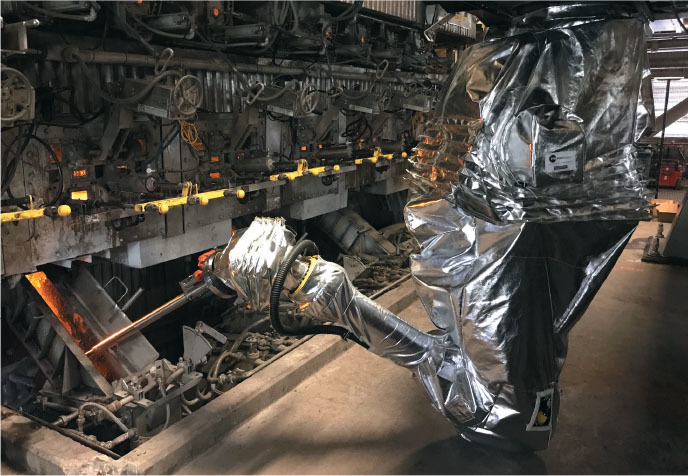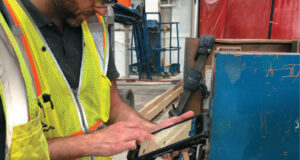
The recovery boiler is at the heart of every integrated pulp and paper mill. While removing smelt deposits from recovery boiler spouts is essential to maintain boiler reliability, the manual cleaning process used by many mills brings the operator close to molten smelt, green liquor, and hot gases, which can lead to safety concerns. As mills strive to enhance safety, they must also meet other complex challenges, from improving resource use to increasing productivity.
RETROFITTING AN EXISTING RECOVERY BOILER
Pixelle Specialty Solutions, a leading manufacturer of specialty papers in North America, sought to further improve mill safety and productivity at its Spring Grove, PA, facility. Like many North American mills, its recovery boiler operators were manually rodding the spouts, placing workers in close proximity to potentially hazardous materials and molten smelt. Jeff Forry, director pulp and utilities, Pixelle, was introduced to the Valmet Smelt Spout Robot during a conference in 2019. Recognizing an opportunity to increase safety, productivity, and performance, he quickly started conversations with Valmet about integrating the technology into the Spring Grove mill.
Although Valmet introduced this technology to European mills in 2008, the Pixelle installation would be the first of its kind in North America. Smelt spout robots have not been adopted as quickly in North America due to a lack of new boilers that can be designed with plenty of space for a robot to operate freely. Most existing boilers were not designed with robotics and autonomous operations in mind, so mills typically need to modify or move existing equipment, piping, and other elements before they can install a smelt spout robot, which can be time-consuming and costly.

COLLABORATING ON A RETROFIT SOLUTION
Longtime partners Valmet and Pixelle began work on the project in 2022. The project included a six-servo motor industrial robot and auxiliary components that would be designed and supplied by Valmet.
The two mounting options for the smelt spout robot are standing or hanging positions, depending on the boiler spout deck arrangement. Pixelle chose to install the hanging version. Currently the only available smelt spout robot that can be mounted on an overhead linear rail assembly, this setup allows the robot to slide side-to-side to clean all spouts and then move off the spout deck when it’s not in an active cleaning cycle.
During the first phase, Valmet upgraded Pixelle’s existing recovery boiler with Valmet smelt spouts and robot-friendly micro-hood systems. Valmet also scanned the recovery boiler with 3D technology to ensure nothing would impede the robot’s installation and operation. This scan helped identify a few potential roadblocks prior to the installation process.
Initially, the two companies planned to install the robot on an overhead steel structure. However, the 3D scanning process revealed that that installation method would have required moving several liquor lines. In addition, the scan showed that the existing beams were not appropriately sized, which would have resulted in the need for Pixelle to install new steel beams able to support the robot and the linear rail.
After further collaboration, Valmet and Pixelle agreed to pivot. The team decided to design customized steel legs to support the robot and linear rail, which would still allow the mill to take advantage of the robot’s overhead linear rail assembly without significant alterations to the boiler house steel.
During the project’s design phase, Valmet met regularly with Pixelle to ensure the spout deck environment was as robot friendly as possible while keeping it safe for operators to enter and work around the spout systems when necessary. Through these conversations, Valmet designed a custom protective fencing system with multiple access and egress points strategically placed throughout.
After completion of the rail system and additional pre-outage work, the robot was installed during a planned outage in June 2023.
RESULT: A SAFER, MORE EFFICIENT FUTURE
The smelt spout robot began operations the same month it was installed. The Valmet robot is not designed to replace operators; instead, the technology protects them from the physical hazards of smelt spout cleaning while allowing them more time to focus on other tasks, such as checking air ports and conducting maintenance rounds.
Running one cleaning cycle every 30 minutes, it cleans twice as often as when operators previously performed manual spout cleaning. Each cleaning cycle takes 15 minutes, with the robot sitting in its home position to the side of the spout deck for an additional 15 minutes.
Operators input a carefully programmed cleaning sequence and maintain control remotely. Also, operators in the mill’s control room use the robot’s onboard camera for ongoing evaluation and troubleshooting, giving Pixelle’s team complete visibility of the robot’s performance.
This game-changing, retrofitted technology from Valmet helps protect Pixelle’s recovery boiler operators from contact with smelt while freeing them up to perform other responsibilities. Furthermore, the automation has improved liquor quality, resulting in a 22.3 percent process improvement in total titratable alkali (TTA) deviation on the dissolver and 2.74 percent improvement in green-to-black liquor standard deviation, while smelt standard deviation improved by 18.6 percent.
 Paper 360
Paper 360

